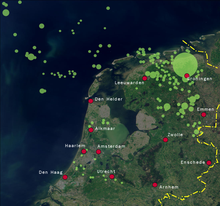Groningen gas field
Revenue from natural gas production became important in the post-war development and construction of the Dutch welfare state.
In 1948, the Nederlandse Aardolie Maatschappij [nl] (NAM), jointly owned by Shell and Esso, discovered a natural gas field in the Netherlands for the first time near Coevorden.
[5] On 29 May 1959, the NAM started exploratory research on land owned by farmer Kees Boon, near Kolham in the municipality of Slochteren.
[4] The cabinet responded to parliamentary questions that a large amount of natural gas had indeed been found, but kept it at 60 billion m3.
At the initiative of Esso employee Douglass Stewart, NAM planned to sell the gas directly to households.
Minister of Economic Affairs Jan de Pous entered into negotiations with NAM about gas extraction.
Shell and Esso initially wanted a substantial majority share in the extraction and sale, to the disapproval of De Pous.
The decision to create a partnership was intended to conceal the fact that the Dutch government participated in natural gas extraction.
With this they tried, among other things, to prevent sheikhs in the Middle East from following the Dutch example of also claiming profits from Shell and Esso, who extracted oil there.
In December 1968, it was celebrated that Egmond aan Zee was the last municipality to be connected to Groningen natural gas.
Only the Groningen Member of Parliament Arend Biewenga [nl] noted that gas extraction in the United States and Italy had led to subsidence.
[4] In an article in the Nieuwsblad van het Noorden, engineer Willem Meiborg warned on 8 November 1963 about subsidence.
It only became public when D66 Member of Parliament Jan Terlouw found out about the research in 1972 and asked parliamentary questions about it.
In the mid-1970s, this policy was revised after the oil crisis of 1973 and the great social resistance to the deployment of nuclear energy.
Because small fields entailed higher operating costs, the Dutch government reduced its profit share to make exploitation more attractive.
[13] Local politician Meent van der Sluis [nl] argued that there was a connection between gas extraction in the Groningen field and the earthquake.
In January 2013, the Minister of Economic Affairs Henk Kamp decided not to limit gas extraction immediately, but requested fourteen investigations.
The report also coincided with austerity measures, which made the government reluctant to reduce natural gas revenues.
As of 2021, the expectation was that the Groningen field would be closed between 2025 and 2028;[26] this timeline was accelerated in 2023, with a target closure date of 1 October 2023.
And as the central point of contact, Hans Alders was appointed in 2015 as National Coordinator Groningen [nl].
Programme coordinator and geophysicist Rinus Wortel called it comparable with the Dutch efforts of protection from the sea.
During the late Carboniferous period, the Netherlands was located on the equator and was covered by tropical swamp forests.
The area was affected by a number of phases of shortening associated with the Alpine orogeny during the Late Cretaceous to Paleogene, which locally reactivated normal faults in reverse sense.
[37] Due to the deviating calorific value and higher pressure, gas-consuming appliances had to be fitted with other burners after 1963 or replaced completely.
[47] With the exception of a few years, the Ministry of Economic Affairs has not tracked how much of the natural gas revenues came from the Groningen field.
[48] Total natural gas revenues, including the small fields, amounted to 417 billion euros until 2018.
[d][49] Unlike other countries, the Minister of Finance Jelle Zijlstra chose not to establish a separate fund for natural gas revenues.
The newspaper stated that natural gas revenues strengthened the currency too much, making it harder for other industries to compete internationally.
Research commissioned by the Instituut Mijnbouwschade Groningen (IMG) conducted by TNO and TU Delft concluded in 2021 that this was not the case.
[56] A reinforcement operation was launched to have houses meet the Meijdam standard, whereby the chance of dying per year from an earthquake must be less than 1 in 100,000.










